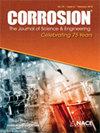Research on dynamic AC corrosion behavior of X65 Pipeline Steel under cathodic protection
IF 1.3
4区 材料科学
Q4 MATERIALS SCIENCE, MULTIDISCIPLINARY
引用次数: 1
Abstract
An indoor corrosion simulation experiment device was built to explore the influence of dynamic AC interference on the corrosion behavior of pipeline steel under different cathodic protection (CP) levels. When the interference time in each interference cycle is 350 s, the dynamic AC corrosion rate was comparable to the steady AC corrosion rate. For JAC of 30 A·m-2, the corrosion rate of the specimen can be controlled below 0.0254 mm·y-1 when the CP current density is higher than 0.06 A·m-2. As JAC is greater than or equal to 100 A·m-2, with the increase of the cathodic protection current density, the corrosion rate of the specimens decreased firstly, then increased and decreased again. In this paper, the real-time AC/DC potential on the surface of the specimen is monitored, combined with Pourbaix diagram and the evolution of corrosion product film, the dynamic AC corrosion mechanism under different cathodic protection levels was explored.X65管线钢阴极保护动态交流腐蚀行为研究
搭建室内腐蚀模拟实验装置,研究动态交流干扰对不同阴极保护等级下管道钢腐蚀行为的影响。当每个干扰周期的干扰时间为350 s时,动态腐蚀速率与稳定腐蚀速率相当。当JAC为30 A·m-2时,CP电流密度大于0.06 A·m-2时,试样的腐蚀速率可控制在0.0254 mm·y-1以下。当JAC大于等于100 A·m-2时,随着阴极保护电流密度的增大,试样的腐蚀速率先减小后增大再减小。本文通过对试样表面交流/直流电位的实时监测,结合Pourbaix图和腐蚀产物膜的演变,探讨了不同阴极保护水平下的动态交流腐蚀机理。
本文章由计算机程序翻译,如有差异,请以英文原文为准。
求助全文
约1分钟内获得全文
求助全文
来源期刊

Corrosion
MATERIALS SCIENCE, MULTIDISCIPLINARY-METALLURGY & METALLURGICAL ENGINEERING
CiteScore
2.80
自引率
12.50%
发文量
97
审稿时长
3 months
期刊介绍:
CORROSION is the premier research journal featuring peer-reviewed technical articles from the world’s top researchers and provides a permanent record of progress in the science and technology of corrosion prevention and control. The scope of the journal includes the latest developments in areas of corrosion metallurgy, mechanisms, predictors, cracking (sulfide stress, stress corrosion, hydrogen-induced), passivation, and CO2 corrosion.
70+ years and over 7,100 peer-reviewed articles with advances in corrosion science and engineering have been published in CORROSION. The journal publishes seven article types – original articles, invited critical reviews, technical notes, corrosion communications fast-tracked for rapid publication, special research topic issues, research letters of yearly annual conference student poster sessions, and scientific investigations of field corrosion processes. CORROSION, the Journal of Science and Engineering, serves as an important communication platform for academics, researchers, technical libraries, and universities.
Articles considered for CORROSION should have significant permanent value and should accomplish at least one of the following objectives:
• Contribute awareness of corrosion phenomena,
• Advance understanding of fundamental process, and/or
• Further the knowledge of techniques and practices used to reduce corrosion.
 求助内容:
求助内容: 应助结果提醒方式:
应助结果提醒方式:


